Circuit Design for High Speed Serial Links
Design circuits for Gigabits of data transfer
3.54 (60 reviews)

280
students
3.5 hours
content
Nov 2024
last update
$39.99
regular price
What you will learn
High Speed Serial Links Overview
Benefits of high speed links
How to decide the Receiver Architecture Design
PLL design Overview
Design of a LC-VCO 10 GHz PLL
CTLE overview
Design of CTLE for 20Gbps high speed link
Active Inductor Design Overview
SerDes Design
Screenshots




Related Topics
3058264
udemy ID
4/27/2020
course created date
5/30/2020
course indexed date
Bot
course submited by